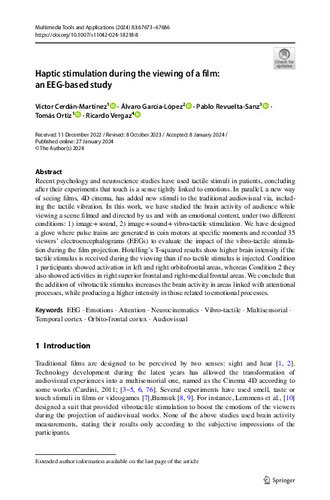Haptic stimulation during the viewing of a film: an EEG-based study
Autor(es) y otros:
Fecha de publicación:
Versión del editor:
Citación:
Resumen:
Recent psychology and neuroscience studies have used tactile stimuli in patients, concluding after their experiments that touch is a sense tightly linked to emotions. In parallel, a new way of seeing films, 4D cinema, has added new stimuli to the traditional audiovisual via, including the tactile vibration. In this work, we have studied the brain activity of audience while viewing a scene filmed and directed by us and with an emotional content, under two different conditions: 1) image + sound, 2) image + sound + vibro-tactile stimulation. We have designed a glove where pulse trains are generated in coin motors at specific moments and recorded 35 viewers’ electroencephalograms (EEGs) to evaluate the impact of the vibro-tactile stimulation during the film projection. Hotelling’s T-squared results show higher brain intensity if the tactile stimulus is received during the viewing than if no tactile stimulus is injected. Condition 1 participants showed activation in left and right orbitofrontal areas, whereas Condition 2 they also showed activities in right superior frontal and right-medial frontal areas. We conclude that the addition of vibrotactile stimulus increases the brain activity in areas linked with attentional processes, while producing a higher intensity in those related to emotional processes.
Recent psychology and neuroscience studies have used tactile stimuli in patients, concluding after their experiments that touch is a sense tightly linked to emotions. In parallel, a new way of seeing films, 4D cinema, has added new stimuli to the traditional audiovisual via, including the tactile vibration. In this work, we have studied the brain activity of audience while viewing a scene filmed and directed by us and with an emotional content, under two different conditions: 1) image + sound, 2) image + sound + vibro-tactile stimulation. We have designed a glove where pulse trains are generated in coin motors at specific moments and recorded 35 viewers’ electroencephalograms (EEGs) to evaluate the impact of the vibro-tactile stimulation during the film projection. Hotelling’s T-squared results show higher brain intensity if the tactile stimulus is received during the viewing than if no tactile stimulus is injected. Condition 1 participants showed activation in left and right orbitofrontal areas, whereas Condition 2 they also showed activities in right superior frontal and right-medial frontal areas. We conclude that the addition of vibrotactile stimulus increases the brain activity in areas linked with attentional processes, while producing a higher intensity in those related to emotional processes.
ISSN:
Patrocinado por:
Universidad Complutense de Madrid
Colecciones
- Artículos [37548]
- Informática [875]
Ficheros en el ítem





